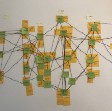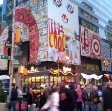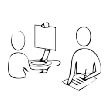Places for everyone
A house is not a home. A space is not a place. Placemaking connects the physical aspect of public spaces with the people's needs, desires, ambitions and leisures. It’s where communities grow and come to life.
Placemaking is a virtuous approach; led by inclusive on-the-ground partnerships that introduce and prioritise neighbourhood voices in the usual duality of civic actors and construction firms. Mutual benefit is the aim of the game.
Consider the placemaking strategy used to ignite footfall in the popular shopping and leisure district at King Street, a stone’s throw from our Manchester office. Visitors to the street increased by 50% from 2019, as vacant units were utilised for pop-up shops for local sustainable brands, the street became a centre point for The Manchester Flower Show, and fundraising activities raised money for the city’s world-renowned Pride festival. Community spirit is celebrated, local businesses boosted, and city administrators can point to a civic success story. Everybody wins.
However, regeneration of public spaces usually occurs in high-income metropolitan centres or areas on the edge of gentrification.There is an ever-present risk that the process of designing amazing places can end up benefiting more privileged communities, some of whom may not even live in those areas. It’s a fine line to walk, and asks difficult questions on who might benefit, and who might be shut out, that placemakers of the future will have to carefully consider.
Our futures are undoubtedly tech-enabled. The origins of the principles of placemaking go back to the 1960s, which leaves the question of where digital interfaces and solutions fit into public places strikingly unanswered, ready for exploration and experimentation. Cities can use smart technologies to improve some key quality-of-life indicators by 10 to 30%, numbers that translate into cleaner streets, shorter commutes, healthier air pollution levels, and happier citizens.
Everyday spaces have the capacity to be transformed into the beating hearts of our civic lives, and placemakers of the future will build on the legacies of the past by understanding how the making of places can build and nurture communities in innovative, inclusive, dynamic, tech-enabled ways. But what are the realities of these connected spaces, and how do we design them to foster happy and healthy communities?
The politics of place.
Space is more of a commodity than ever, especially in congested cities. “The pandemic has exposed the gulf between the space-poor and the space-rich to create a new politics of resentment, a coarsening of discourse,” says Roger Boyes, Diplomatic Editor for the Times. A balcony, a private garden, a safe public park. These aren’t readily accessible to a wide swathe of the population, impacting mental health, widening inequalities and even stunting the development of children.
Designing public places for communities is therefore an incredibly charged process, especially when the question of who exactly will be benefiting is considered. There’s a pattern of placemaking acting to further existing inequalities, benefitting what placemaker and author Jay Pitter refers to as the ‘dominant density’, the urban pockets designed by and for predominantly white, middle-class people, to the exclusion of the ‘forgotten densities’ present in social housing and low-income portions of a city. We can all think of examples of once loud, boisterous and colourful areas in our cities that have since become muted through the building of well-meaning but ultimately damaging public places.
This need not always be the case. Barcelona has used the unique design of its gridded streets to create superillas (superblocks) across the city, imposing one-way systems and speed limits around neighbourhoods to reduce traffic and convert unused lanes to walkable community spaces. The creation of the superillas was a collaborative process between residents and City Hall, and the first superblock in Poblenou was built in a neighbourhood consisting of social housing. The ‘forgotten densities’ were not forgotten.
Placemaking theoretically protects the culture and spirit of a public place. How do we create inclusive environments that engage and galvanise our societies? What’s the role of business vs government and who is ultimately accountable for the sanctity of our spaces?
Connecting connected cities.
Smart cities and strategies start with people, not technology. Incorporating digital capabilities into our public spaces can embody the spirit of placemaking, by allowing people to make better decisions and deliver a better quality of life.
Look at Singapore, which stands atop the Smart City Index. One of its crowning achievements is the Smart Health TeleRehab programme, allowing senior citizens access to devices to be able to get medical help at any point in time, in any part of the city. Or Los Angeles’ ambitious SmartLA 2028 strategy, which hopes to digitise over 1,500 city services onto an intuitive digital platform for all Angelenos, using a multilingual AI bot to make sure that the city can serve all corners of its diverse populace.
But the scope for innovation and imagination could surely go so much further. Digital solutions could be used to mobilise non-native speakers, or disabled members of communities, to more heavily weigh in on the collaborative process of building public spaces. The breaking of the barrier to communication and mobilisation could nearly double the share of residents who feel connected to the local community, and nearly triple the share who feel connected to local government, according to a study by McKinsey. As well as improving the quality of life for residents, connected communities are also liable to feel even more empowered in their cherished civic places.
How can we look beyond technology for technology’s sake, and use data to make the experience of enjoying a place seamless for the community, improving the quality of life for our residents? And how can connected communities evolve placemaking to be even more inclusive, bottom-up and collaborative?
On 13th September we’re hosting an event on this topic. Register for free to add your voice to the conversation. We already have leaders from TFL, Landsec, Jacobs and Octopus attending. Exchange: Amazing Places.
Magnetic is a design and innovation company that helps design better futures. We’ve worked with global businesses to build capabilities and transform organisations. If you’d like to find out more about our work, get in touch with Dean Wilson or drop us a line.
Author: Aidas Zvirblis





